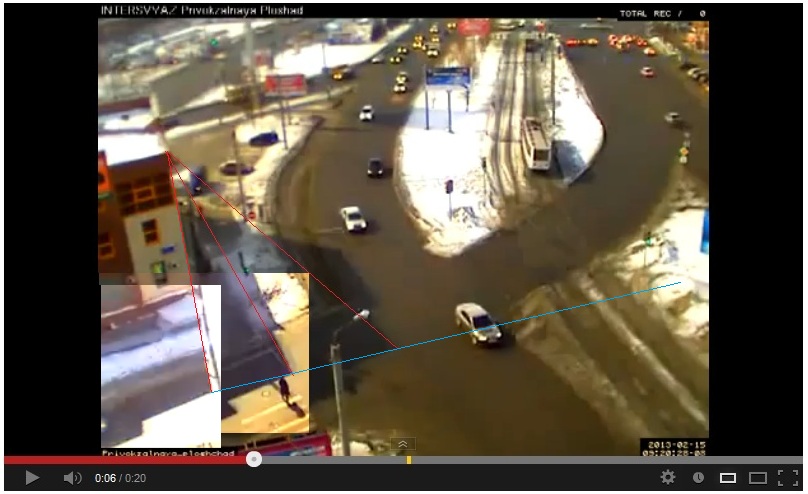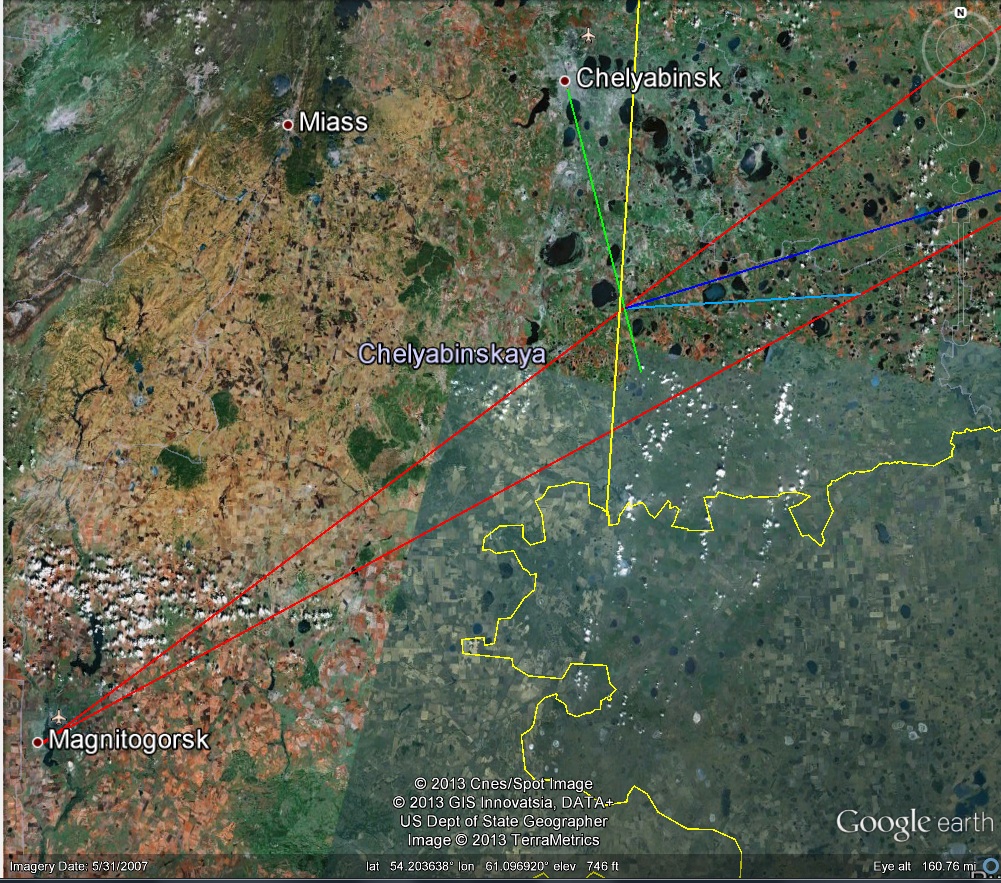Like many others, I was astounded not only by the Chelyabinsk meteor fall itself, but by the seemingly outlandish estimates of the power of the “explosion” which was presumed to have caused the damage on the ground. I believe they’re saying 500 kilotons now. At one point I was ready to give in and go along, but in perusing the extensive Youtube material and other references, I saw others voicing many of the same points that I had thought of, for example that “there was no explosion” ( ! ) How can you say there was no explosion ! Well, because the brilliant flash lasting for several seconds traveled through the air for some miles during that time, then blinked out. What was left was a smoke trail. Then, a LONG time later, as much as two minutes it seems, there was a huge but very sharp crack that did the damage, followed by a series of much less intense bangs and pops that sounded like gunfire. It certainly seems that all of these were “sonic booms”.
Well, enough generalities. Let’s just look at a simple analysis of the “traffic camera” video. Here’s a composite of three frames with some lines drawn on it:

The red lines are drawn from the corner of the building to its shadow at three different times, with the lapse of 2.0 seconds, and 1.0 seconds between them. The two later shadows were pasted on to the original scene. Then the blue line connecting them gives a record of the track of the meteor flash in the sky. The corner of the building has ( lat, long ) = ( 55.143470, 61.414289 ), incidentally. That was some sleuthing right there! The view is slightly to the east of due south.
Now concentrating on the last interval of one second, we see that this is near the closest approach of the meteor to this location, and eschewing trigonometry, we can estimate that the red sides of the triangle formed by the line of sight forming the shadow track, are to the blue baseline of the track, as 8 to 3. We simply note that we are looking more or less face on to the triangle from the vantage of the camera and estimate from the image.
The point is that the distance of the meteor from the location is in the same 8 to 3 ratio to the distance it flew during that one second. Suppose it was moving at Mach 10, then it flew about 2 miles in that time, and the distance is then 16/3 miles, or say 6 miles … not very far away! We may suppose about 4 miles high and 4 miles along the ground.
I had first noticed that the elevation above the horizon changed considerably among the videos that seemed to be taken around the Chelyabinsk area. ( There is one stated to be from Magnitogorsk, which is 150 miles away. The angle of view looks right, but 4 miles only gives you about 1.5 degrees above the horizon. It was very low, actually, so I’m sticking with my estimates for now. )
In several videos people are standing around gawking at the smoke trail when the big bang comes. I saw a comment saying that the bang was produced earlier and this is why it arrived so late, as the meteor outran it over a long distance. I had started thinking that myself when I decided that the smoke trail couldn’t be 20 miles high, and 500 kilotons just does not compute!
Anyway, I think the shadow videos ( there’s another of the Chelyabinsk city square ) are very robust evidence.
Update:
I sleuthed the location of the Magnitogorsk video, which enabled me to get a triangulation on the meteor path based on local landmarks. The red lines on the Google Maps screen shot are my estimates of the lines of sight to the first appearance ( on the right ) and the flareup from the site. Being at right angles to the Chelyabinsk lines of sight estimated from the shadow video, I think it gives a pretty good location, although far from exact. It’s much further south of Chelyabinsk than I had been thinking, which means it’s a lot higher ( ahem ). The yellow line is a line of sight to the flareup from Kamensk-Uralsky, about 100 miles north of Chelyabinsk. The dark blue line is parallel to the ground track of the shadow in Chelyabinsk, and the light blue line is an attempt to account for the tilt of the trajectory, which means it must be displaced that way, but maybe not that much.
 BTW, putting the track to the south this way makes a discrepancy with its placement in the weather satellite photo, so that’s another problem. One must have patience.
BTW, putting the track to the south this way makes a discrepancy with its placement in the weather satellite photo, so that’s another problem. One must have patience.
Update 2:
Here’s a Colorado State University montage incorporating an annotated version of the extant weather satellite image of the Chelyabinsk Meteor plume ( btw, that’s “che YAH binsk”, as I hear it in Russian reportage ) :
… and here’s an overlay of my marked up Google Earth image from above, aligned using the dark spots which appear near “Chelya..” as above:

The “dark spots” line up very well, so the overlay seems accurate. Note the excellent agreement of my line-of-sight location of the “flash” with the “plume turrets” identified by CSU. Note also my UNDERestimation of the effect of the inclination on the estimation of the ground track based on the shadow track. The extra light blue lines radiating from Kamensk-Uralsky are my estimate of the extent of the visible smoke trail in the seconds after the flash. This includes a significant length to the west of the flash, as shown also in the CSU montage.
So, I guess I should be happy now, but I still can’t bring myself around to 500 kilotons!
